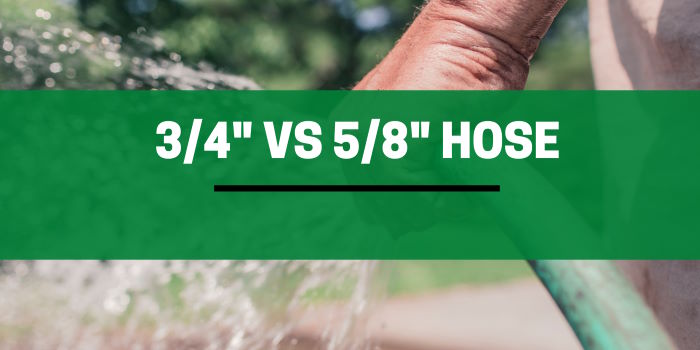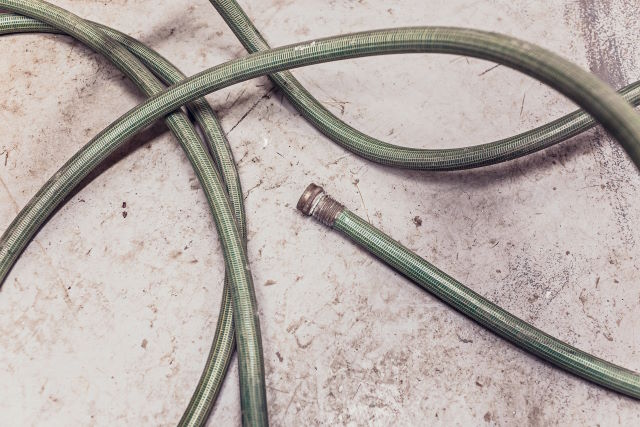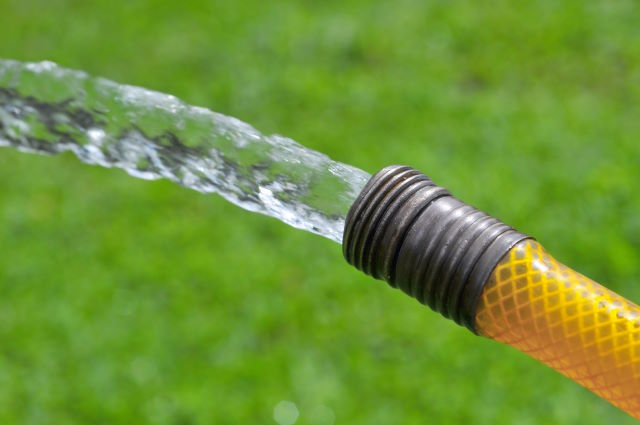
Garden hoses are essential tools for every homeowner. But, with various types and sizes available, choosing the right one can be a challenge.
In this article, we’ll dive into the differences between ¾-inch and ⅝-inch hoses, their benefits, and how to choose the best one for your needs.
Contents
Hose Diameter Summary
¾-inch and ⅝-inch water hoses are the most common diameters. The key difference between them is that ¾ inch hoses have a larger diameter, which allows for more water flow and offers better resistance to kinking and twisting.

On the other hand, ⅝-inch hoses are more flexible, and lightweight, and usually come at a cheaper price point.
Both of these hose diameters share the same ¾-inch connection size. So the same attachments can be used for either.
Eiter diameter hose will fit an outdoor spigot which will usually have a ¾-inch connection.
Key factors to consider include the water hose length, overall construction quality, and most crucially, the available hose width.
Many gardeners find themselves perplexed when it comes to choosing between the different hose widths available, considering their budget and needs.
Benefits of 3/4 Inch Hoses
Larger Internal Diameter
The larger internal diameter allows for a higher volume of water to pass through, making it perfect for tasks that require a constant discharge rate, like irrigation, filling a pool, running sprinklers, or maintenance of a large backyard lawn.
It’s important that any adapters or attachments that you use with this hose size also have a ¾-inch internal diameter to fully benefit from the larger hose diameter.
Higher Water Flow Rate
A ¾-inch hose can deliver more gallons per minute (GPM) than a ⅝-inch hose.

This extra amount of water volume in a shorter period can make it a suitable choice for tasks that need increased water pressure, such as pressure washing your driveway or patio.
Greater Resistance to Kinking and Twisting
Due to their larger diameter, ¾-inch hoses are less likely to kink or twist, ensuring a smooth and consistent water flow. This is especially helpful when using hose reels, as they reduce the chances of hose damage.
It is also more common to find heavy-duty varieties in this diameter. So you can often expect these to also be more resistant to extreme weather.
Benefits of 5/8 Inch Hoses
Easier to Store & More Portable
Since ⅝-inch hoses are lighter and more flexible, they’re easier to store and carry around. Being more portable means that they’re an ideal choice for smaller gardens or when you need to move them frequently.
Cheaper Price
⅝-inch hoses are usually more affordable than ¾-inch hoses, making them a popular option for homeowners who don’t require extra water flow and are looking for a budget-friendly solution.
They are also more widely available in most stores including supermarkets. The same goes for their connectors, fittings, and accessories.
More Flexible
A ⅝-inch hose is more flexible and easier to maneuver, making it perfect for basic operations like watering plants or washing your car.
Higher Water Velocity
A smaller area within the hose means that water will travel at a higher speed within it. This high water velocity may be useful for cleaning using a jet nozzle or covering a wider area with a sprinkler.
But there will still be less volume of water passing through the hose overall when compared to one with a larger diameter.
Comparison of 5/8 vs 3/4 hoses
| ⅝ Inch Hose | ¾ Inch Hose | |
| Water Velocity | Higher water velocity | Lower water velocity |
| Water Pressure | Lower water pressure | Higher water pressure |
| Discharge Capacity | Lower water discharge capacity per minute | Higher water discharge capacity per minute |
| Durability | Less durable | More durable |
| Availability | More available | Less available |
| Price | Cheaper | More expensive |
Which Diameter Is Best?
Maintaining a Large Lawn or Yard
If you have a large backyard lawn, a ¾-inch hose is your best bet. The extra water flow and larger internal diameter will help you cover more ground efficiently and keep your lawn looking its best.
Pressure Washing
When it comes to pressure washing, a ¾-inch hose is a way to go. The increased water pressure and ability to move higher volumes of water make it ideal for feeding a pressure washer. So then you can tackle stubborn dirt and grime on surfaces like driveways, sidewalks, and patios easier.
Lawn & Garden Maintenance
For general lawn and garden maintenance, a ⅝-inch hose is a fantastic choice. It’s more affordable, easier to handle and store, and provides enough water flow for most watering tasks.
Remember that most nozzles and couplings will fit either size.
Miscellaneous Applications
For other applications such as filling a pool, a larger ¾-inch hose can help to complete the task quicker.
For tasks such as washing your car, or cleaning outdoor furniture, either a ⅝-inch or ¾-inch hose can get the job done. Consider your specific needs, budget, and storage space when making your decision.
Conclusion
In summary, both ¾ inch and ⅝ inch hoses have their unique advantages. The ¾-inch hose offers a higher water flow, making it perfect for large lawns and pressure-washing tasks. Meanwhile, the ⅝-inch hose is more affordable, flexible, and easier to store, making it suitable for everyday gardening tasks.
Ultimately, the best size depends on your specific needs and preferences. By considering the benefits of each type, you can make an informed decision and choose the perfect hose for your home.
Frequently Asked Questions
Can I use a 5/8-inch hose for pressure washing?
While it’s possible to use a ⅝-inch hose for pressure washing, a ¾-inch version is better suited due to its higher water flow and pressure capabilities.
Which diameter hose is more durable?
Both hose sizes can be equally durable, depending on the quality of materials used in their construction. Look for those manufactured from premium materials like rubber or reinforced vinyl to ensure longevity.
Which size is compatible with my hose reel?
Most hose reels are designed to accommodate both ¾-inch and ⅝-inch hoses. However, it’s always best to check the manufacturer’s specifications to ensure compatibility.
Can I connect different hose diameters together?
Yes, you can connect hoses of different diameters using adapters. Make sure to choose a connector with the appropriate Garden Hose Thread (GHT) size for a secure fit.
